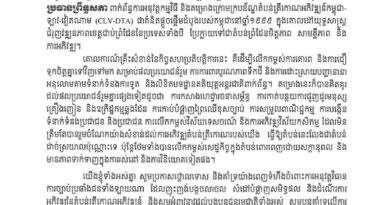ក្រុមការងាររបស់នាយកដ្ឋានអភិរក្សប្រាសាទ និងបុរាណវិទ្យា នៃអាជ្ញាធរជាតិអប្សរា កំពុងតែខិតខំប្រឹងប្រែងរុះរើផ្ទាំងថ្មនៃប្រាសាទបុរាណចំនួនច្រើនម៉ឺនដុំចេញពីគំនរដែលធ្លាប់តែធ្លាក់នៅក្នុងស្រះទឹកនាភាគខាងកើតនៃប្រាសាទបាយ័ន ដើម្បីផ្លាស់ប្ដូរទៅកាន់ទីតាំងថ្មីមួយផ្សេងទៀត។
បុគ្គលិកបច្ចេកទេសនាយកដ្ឋានអភិរក្សប្រាសាទ និងបុរាណវិទ្យា នៃអាជ្ញាជាធរជាតិអប្សរា លោកស្រី ទឹម ធីតា មានប្រសាសន៍ថា ការរុះរើបំណែកថ្មនៃប្រាសាទបុរាណចេញពីស្រះទឹកនេះ គឺក្នុងបំណងរៀបចំសណ្តាប់ធ្នាប់គំនរថ្ម និងដឹកជញ្ជូនទៅរក្សាទុកនៅទីតាំងសមស្រប។ ម្យ៉ាងទៀត គឺដើម្បីលើកតម្លៃ នឹងស្តារស្រះទឹកទាំង២នៅភាគខាងកើតប្រាសាទបាយ័នឡើងវិញ ឱ្យដូចទៅនឹងអត្តសញ្ញាណដើម និងទម្រង់ស្ថាបត្យកម្មដើមនៃប្រាសាទបាយ័នទាំងមូលផង។
លោកស្រី ទឹម ធីតា ឱ្យដឹងទៀតថា គំនរថ្មនៃប្រាសាទបុរាណនេះ មួយផ្នែក ធ្លាប់បានប្រមូលនៅក្នុងបរិវេណរួតទី៣ និងនៅរោងទងទី១នៃប្រាសាទបាយ័នដោយអ្នកអភិក្សជនជាតិបារាំង កាលពីចន្លោះឆ្នាំ១៩១៩-១៩៣០ម្ដងមកហើយ។ ក្រុមអ្នកជំនាញឱ្យដឹងថា ថ្មប្រាសាទបុរាណភាគច្រើនដែលធ្លាក់ជាគំនរនៅក្នុងស្រះទឹកនាភាគខាងកើតនៃប្រាសាទបាយ័ននោះ គឺជាប្រភេទថ្មដំបូល៥០ភាគរយ ក្រៅពីនេះមាន ថ្មហោជាង ធ្នឹម សសរ ថ្មកំពូលព្រហ្ម ខឿន និងថ្មចម្លាក់តូចៗដែលបានបាក់បែកមុខជាដើម។ ស្ថានភាពថ្មមុនពេលរើ គឺមានសភាពនៅរាយប៉ាយគរគ្នា និងគុណភាពថ្ម ឃើញនៅល្អភាគច្រើន។
ដំណាក់កាលដំបូង គឺក្រុមការងារនឹងរើគំនរថ្មយកទៅដាក់នៅបរិវេណមុខប្រាសាទសិន បន្ទាប់ពីរើថ្មអស់ហើយ គឺក្រុមការងារនឹងត្រូវបែងចែកប្រភេទថ្មថា មួយណាជាប្រភេទថ្មដំបូល ថ្មណាជាសសរ ដោយត្រូវយកទៅដាក់នៅផ្នែកខាងជើងនៃប្រាសាទបាយ័ន។ រហូតមកដល់ពេលនេះ ក្រុមការងារនៃអាជ្ញាធរជាតិអប្សរាបានរើផ្ទាំងថ្ម នៃប្រាសាទបុរាណទៅដាក់នៅផ្នែកខាងជើងនៃប្រាសាទបាយ័ន បានចំនួនប្រហែលជាង៤ពាន់ដុំហើយ។
ក្រុមការងារបានសន្និដ្ឋានថា ថ្មប្រាសាទបុរាណ ដែលគេត្រូវរើចេញពីគំនរទាំងអស់មានប្រហែល២ម៉ឺនដុំ។ ការងាររុះរើផ្ទាំងថ្មនៃប្រាសាទបុរាណចេញពីគំនរដែលធ្លាប់តែនៅក្នុងស្រះទឹកនាភាគខាងកើតនៃប្រាសាទបាយ័ន គឺបានចាប់ផ្តើមតាំងពីដើមឆ្នាំ២០២៣មកម៉្លេះ ដោយដំណាក់កាលដំបូងចាប់ផ្តើមពីការសិក្សាស្វែងរកឯកសារ ការសម្រង់ប្លង់ ថតរូបស្ថានភាពថ្មមុនពេលរើ ហើយក៏គ្រោងនឹងបញ្ចប់នៅខែសីហាឬខែកញ្ញាខាងមុខនេះ ៕
អត្ថបទ៖ ឆាយ ផាន់នី
រូបភាព៖ យី សុថា/ ភោគ ជា
APSARA National Authority plans to restore two ponds in the east of the Bayon temple
A working team from the Department of Conservation of Monuments and Preventive Archaeology of the APSARA National Authority is working to remove thousands of stone blocks from piles that fell into the ponds in the east of the Bayon temple.
The technical staff of the Department of Conservation of Monuments and Preventive Archaeology of the APSARA National Authority, Ms. Tim Thida, said that the removal of the stone blocks from the ancient ponds is to organize and transport them to store appropriately. On the other hand, to raise the value and restore the two ponds to the original identity and architectural form of the Bayon temple.
Ms. Thida said that part of the stone pile of this ancient temple was once collected in the third compound and the first gallery of the Bayon temple by the French curator between 1919-1930. She added that 50% of the stone blocks that fell into the ponds in the northeast of the Bayon temple were the roof stones, and some stones from the pediment, the beams, the pillars, platforms, and the small carved stone that broke the face. The condition of the stones before moving is scattered and the quality of the stones is mostly good.
Firstly, the team moved the pile of stones to the front of the temple. After the stones are removed, the team will divide the types of stone such as roof stone, and pillars, which will be placed on the north side of the Bayon temple. So far, the working team of APSARA National Authority has moved the stone blocks to the north of the Bayon temple about 4,000 blocks.
The team estimated that the ancient stones that had to be removed from the piles were about 20,000 blocks.
The work of removing the stone blocks from the ponds in the east of the Bayon temple began in early 2023, with the first phase starting from the study of documents, photographing the condition of the stone before moving, and is scheduled to be completed in August or September.
Article: Chhay Phanny
Photos: Yi Sotha / Phouk Chea





